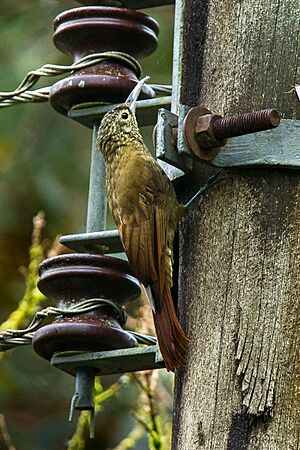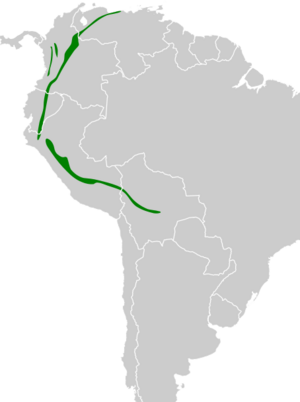Olive-backed woodcreeper facts for kids
Quick facts for kids Olive-backed woodcreeper |
|
|---|---|
 |
|
| Conservation status | |
| Scientific classification | |
| Genus: |
Xiphorhynchus
|
| Species: |
triangularis
|
 |
|
The olive-backed woodcreeper (Xiphorhynchus triangularis) is a type of bird found in the forests of South America. It belongs to the family called Furnariidae, which includes ovenbirds and woodcreepers. You can find this bird in countries like Bolivia, Colombia, Ecuador, Peru, and Venezuela.
Contents
About the Olive-backed Woodcreeper
Bird Family and Types
The olive-backed woodcreeper is part of a group of birds known as woodcreepers. Long ago, people thought the olive-backed woodcreeper and the spotted woodcreeper were the same species. But since the mid-1900s, scientists have decided they are actually different birds.
There are four main types, or subspecies, of the olive-backed woodcreeper:
- X. t. triangularis
- X. t. hylodromus
- X. t. intermedius
- X. t. bangsi
What Does It Look Like?
The olive-backed woodcreeper is a medium-sized bird, usually about 19.5 to 25 cm (7.7 to 9.8 in) long. Males weigh around 40 to 52 g (1.4 to 1.8 oz), and females are a bit lighter, weighing 32 to 48 g (1.1 to 1.7 oz). Both male and female birds look very similar.
This bird has a beak that curves slightly downwards. Its face has fine streaks, with a light buffy stripe above its eye and around it. The top of its head and the back of its neck are dark brownish-black with light, long spots.
Its back and wings are a bright olive or brownish-olive color. The upper part of its back has a few light streaks. The feathers covering its tail are a warm cinnamon or reddish-brown color. Its tail itself is a dark reddish-brown.
The bird's throat is a light, buffy white with a pattern that looks like dark brownish-black scales. Its belly is a slightly lighter olive than its back. The chest has many light, whitish spots that become more triangular towards the belly. Its legs and feet are blue-gray. Young birds look similar to adults but are a bit duller.
Each subspecies has slight differences:
- X. t. hylodromus has brighter olive-brown upper parts.
- X. t. bangsi has more reddish (less olive) upper parts. Its head spots are larger, and its back has clearer streaks.
- X. t. intermedius is a mix between the main type and bangsi.
Where Does It Live?
The different types of olive-backed woodcreepers live in various parts of South America:
- X. t. hylodromus lives in the mountains of northern Venezuela.
- The main type, X. t. triangularis, is found in the Andes mountains from western Venezuela, through Colombia, eastern Ecuador, and into northern Peru.
- X. t. intermedius lives on the eastern side of the Andes in Peru.
- X. t. bangsi is found on the eastern side of the Andes from southeastern Peru into central Bolivia.
This bird prefers to live in the middle parts of the Andes mountains. It likes humid, evergreen montane forests (mountain forests) and very wet cloudforests. It can also be found in elfin forests, which are forests with small, twisted trees.
It mostly stays inside old, untouched forests, but sometimes it can be seen at the edges or in forests that have grown back after being cut down. You can usually find it between 1,000 and 2,400 m (3,300 and 7,900 ft) high in the mountains.
Behavior of the Woodcreeper
Movement and Daily Life
Scientists believe that the olive-backed woodcreeper stays in the same area all year round. It does not migrate to other places.
What Does It Eat?
While we don't know every detail of its diet, the olive-backed woodcreeper mainly eats arthropods, which are creatures like insects and spiders.
It usually looks for food alone or in pairs. Sometimes, you might see small groups of them. They also sometimes join mixed-species feeding flocks, which are groups of different bird species hunting for food together.
The woodcreeper moves up and along tree trunks, vines, and large branches. It usually hunts in the middle and upper parts of the forest. It finds a lot of its food in clumps of moss. It also picks food from the surface and cracks of tree bark, and from epiphytes (plants that grow on other plants).
Reproduction and Life Cycle
We don't know everything about when and how the olive-backed woodcreeper breeds. In northern Venezuela, they seem to nest from April to June. They also appear to nest during this time in parts of Colombia. However, in eastern Colombia, they might nest a bit later. Beyond these details, not much else is known about how they raise their young.
How It Sings
The olive-backed woodcreeper is not as vocal as some other birds in its group. Its song is a series of strong notes that start fast and then slow down. It sounds like "we we we-we-we-we-we-WE-WE-We-we-wa."
It also has a softer song, which is a weak and slightly nasal series of notes that speeds up into a slow trill, like "quee, quee QUEE-que-que’e’e’e’e." Its most common call is a sharp, piercing sound that goes down in pitch, like "keeeyur." Sometimes, this call is mixed with a series of musical notes.
Status and Conservation
The IUCN (International Union for Conservation of Nature) has evaluated the olive-backed woodcreeper and listed it as a species of "Least Concern." This means that, for now, it is not considered to be in immediate danger of disappearing.
Even though it lives in a fairly large area, we don't know exactly how many olive-backed woodcreepers there are. However, scientists believe their numbers are slowly decreasing. No major threats have been identified right now.
The bird is considered uncommon to fairly common throughout its range. It mostly lives in old, untouched forests, which means it can be very sensitive to human activities that disturb these forests. Protecting these forests is important for the olive-backed woodcreeper's future.


